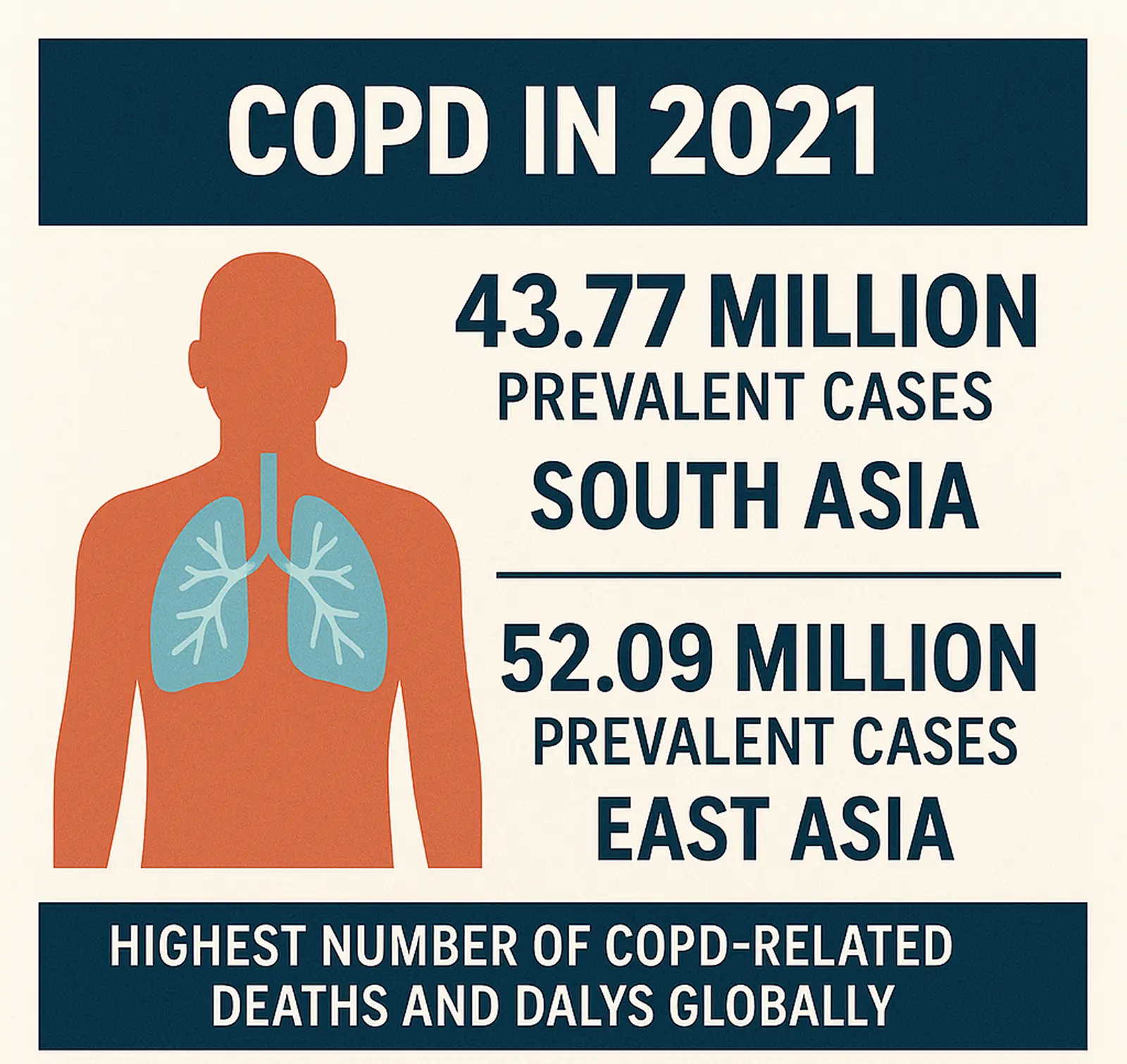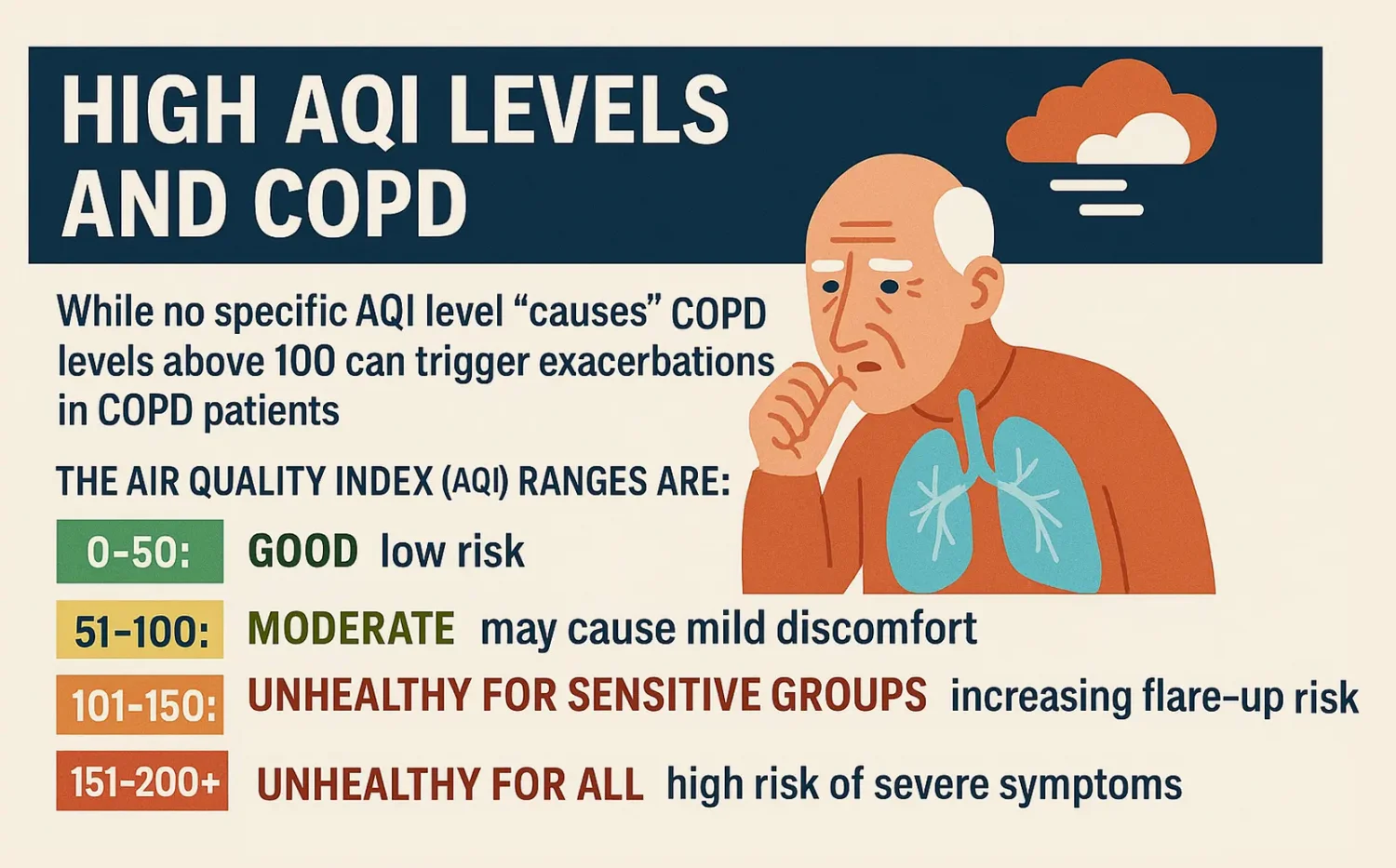In 2021, Chronic Obstructive Pulmonary Disease (COPD) caused about 3.5 million deaths worldwide. As a result it becomes the fourth leading cause of death. That’s roughly 1 in every 20 deaths. Back in 1990, COPD deaths were around 2.5 million, but by 2021, this number jumped to 3.72 million. Air pollution and lifestyle factors are making this lung disease more common, especially in cities with poor air quality. So Let us know how air pollution fuels COPD and what you can do to stay safe.
What is COPD?
COPD is a group of lung diseases, like emphysema and chronic bronchitis, that make breathing difficult. Common symptoms include:
- Shortness of breath, especially during activity
- Constant cough, often with mucus
- Wheezing
- Chest tightness
- Feeling tired
- Frequent lung infections
These symptoms start slowly and get worse over time, especially in people over 35 who smoke or are exposed to pollutants.
How Air Pollution Fuels COPD?
Air pollution plays a big role in both causing COPD and making it worse. Know how Harmful pollutants in air pollution fuels copd, it include:
- Particulate matter (PM2.5, PM10): Tiny particles from car exhausts, factories, or burning wood.
- Ozone (O₃), sulfur dioxide (SO₂), nitrogen dioxide (NO₂), carbon monoxide (CO), and lead (Pb): Gases from vehicles, industries, and burning fuels.
When you breathe these pollutants, they irritate your lungs, causing inflammation. Over time, this damages lung tissue and narrows airways, making it harder to breathe. For people with COPD, pollution can trigger exacerbations—sudden worsening of symptoms like coughing or shortness of breath—that may require hospital visits. Studies show pollutants can carry germs, weaken lung defenses, and increase these flare-ups. Women in developing countries, exposed to smoke from cooking with wood, face an even higher risk.
The Numbers: Air Pollution Fueld COPD Cases in the World

- In 2016, air pollution caused 4.2 million deaths globally, with about 25% linked to COPD (World Health Organization).
- Indoor and outdoor air pollution together caused 7 million deaths the data from 2012
- COPD affects 11.7 million adults in the U.S.
- In 2021, South Asia had 43.77 million COPD cases, and East Asia had 52.09 million, with both regions seeing the highest COPD-related deaths.
Recognizing COPD Symptoms
COPD symptoms develop slowly but can disrupt daily life. Look out for:
- Trouble breathing, especially during exercise
- Constant cough with mucus
- Wheezing sounds when breathing
- Tight chest
- Feeling exhausted
- Frequent colds or lung infections
During an exacerbation, these symptoms can worsen suddenly and last for days, often needing extra medication. Early detection is key to starting treatment and protecting your lungs.
Air Quality Index (AQI) and COPD
The Air Quality Index (AQI) measures how polluted the air is. Higher AQI means worse air quality, which fuels COPD symptoms in patients. Here’s a simple breakdown:

0-50 (Good): Safe for everyone.
51-100 (Moderate): May cause mild discomfort for sensitive people.
101-150 (Unhealthy for Sensitive Groups): Can trigger COPD symptoms.
151-200 (Unhealthy): Risky for everyone, especially COPD patients.
201+ (Very Unhealthy/Hazardous): High chance of severe symptoms and hospital visits.
Check AQI levels on sites like AQI.in to plan your day. Avoid outdoor activities when AQI is above 100, as exacerbations can take weeks to recover from and harm your lungs further.
How to Protect Yourself from Air Pollution?
Reducing exposure to air pollution is crucial to protect yourself from developing COPD. Try these tips:
- Stay indoors on high AQI days: Keep windows and doors closed to block pollutants.
- Use air purifiers: HEPA filters can clean indoor air by trapping harmful particles.
- : Check with your doctor, as masks may make breathing harder for some.
- Avoid peak pollution times: Stay inside during rush hours or hot, sunny days. Early mornings or evenings are often safer.
- Follow your COPD plan: Take prescribed inhalers and stay up to date on flu and pneumonia vaccines to lower infection risks.
- Reduce indoor pollution: Avoid smoking, wood stoves, or cooking methods like frying that release fumes.
Living Well with COPD
Managing COPD takes effort, but these steps can help:
- Medications: Use inhalers or corticosteroids as prescribed.
- Pulmonary rehabilitation: Programs with exercise and education improve lung function.
- Stay active: Try gentle exercises like walking or swimming.
- Eat healthy: Nutritious foods boost your immune system. Stay hydrated to keep airways moist.
- Join support groups: Connect with others for emotional and practical support.
- Monitor symptoms: Have an emergency plan for exacerbations to act quickly.
Cities with High COPD Risk
Air pollution is worse in some cities, increasing COPD risk, especially in South and Southeast Asia:
- Delhi, India: Heavy traffic, factories, and biomass burning create extreme pollution.
- Beijing, China: Industrial emissions and dense urban areas worsen air quality.
- Jakarta, Indonesia, and Dhaka, Bangladesh: Poor infrastructure and indoor fuel use add to pollution.
- San Joaquin Valley, USA: PM₂.₅ levels hit 17 µg/m³, higher than California’s limit (12 µg/m³) and the U.S. standard (9 µg/m³), trapping pollutants in a “pollution bowl.”
Globally, 90% of COPD deaths in people under 70 happen in low- and middle-income countries (World Health Organization).
Conclusion
Air pollution is a major concern that can cause COPD, causing new cases and worsening symptoms for those already diagnosed. By understanding how pollution affects your lungs, recognizing symptoms early, checking AQI levels, and taking protective steps, you can reduce risks. Cities with high pollution need urgent action to improve air quality. With smart strategies and proper care, you can manage COPD and live better despite the challenges of air pollution.
Note: All the images used in this blog are AI-Generated.